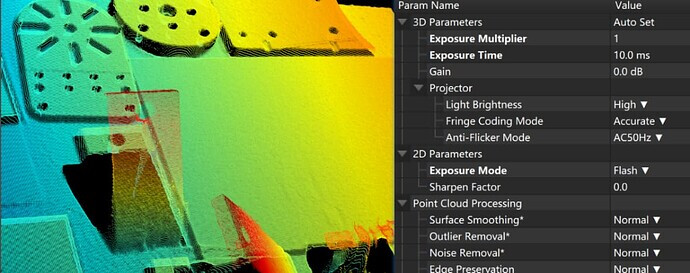Background
For Mech-Eye PRO S, PRO M, and NANO cameras, there are two types of 3D cameras available: monochrome versions, and color versions. This article provides advice on how to determine which type of camera to choose for a target scene, along with the principles behind these recommendations.
Selection Recommendations:
-
For presentation and research-oriented requirements, consider the color version of the camera, as it can provide richer RGB information for better display quality. For specific project requirements in particular scenes, refer to conclusion 2.
-
If the target scene includes colorful items (such as general merchandise, colorful boxes, etc.) and 2D recognition using deep learning is needed, choose the color version of the camera. Otherwise, it is recommended to prioritize the monochrome version of the camera. Monochrome cameras offer better point cloud quality and stronger resistance to ambient light interference.
Principle Explanation
Below, we will explain the differences in design between the monochrome version and the color version of the 3D cameras, as well as the resulting differences in performance.
The monochrome version of the PRO camera utilizes a monochrome image sensor and a monochrome (blue) light source DLP projection. It is coupled with a narrowband filter that only allows blue light to pass through, ensuring that the projection signal is effectively received by the sensor. Most ambient light is filtered out by the filter, thereby preventing interference from ambient light in 3D imaging.
The color version of the PRO camera uses an RGB tricolor image sensor and a white light source DLP projection. It can output 3D point cloud data as well as RGB color 2D image data. Since it does not have a narrowband filter (which would affect the effectiveness of the RGB 2D image if installed), 3D imaging can be affected in environments with strong ambient light.
Advantages of Monochrome Sensor Compared to RGB Sensor
Lower Image Noise and Higher Resolution
Monochrome sensors capture images with lower noise and higher resolution. Because monochrome sensors don’t need to separate information from different color channels, they can provide higher image resolution. Consequently, the Signal-to-Noise Ratio (SNR) of the image is higher.
Higher Sensitivity of Monochrome Sensors
Compared to multicolor sensors, multicolor sensors have Bayer filters in front of them, allowing each pixel to detect photons of a specific color—red, green, or blue. Therefore, it has fewer effective pixels than the underlying monochrome sensor and lower sensitivity.
Predictable Clipping with Monochrome Sensors, Larger Dynamic Range
For color sensors, clipping can occur only in the red, green, or blue channel, while for monochrome, clipping is an all-or-nothing process.
Lower Exposure Needed for Monochrome Sensors to Achieve Good Point Clouds
When converting RGB to grayscale, exposure needs to be increased because red and green light has lower brightness compared to blue light. To achieve the same grayscale situation as a black and white camera, exposure needs to be increased.
Color camera, 3D exposure, 10ms:

Monochrome camera, 3D exposure, 5ms:

Predictable Clipping
When the sensor’s dynamic range is insufficient to record the maximum or minimum brightness of a scene, the image can become distorted. Distorted pixel values are clipped to the current maximum and minimum values that can be expressed (which are the maximum and minimum of the dynamic range).
Because color information is in three channels—red, green, and blue—clipping can occur in any of these channels. This phenomenon reduces the overall available dynamic range of the entire image, thereby affecting image quality and point cloud quality.
